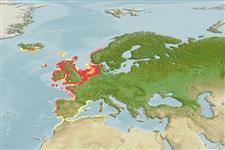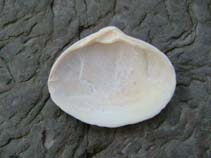Advertisement
Spisula solida (Linnaeus, 1758)
Solid surf clam| Native range | All suitable habitat | Point map | Year 2050 |

|
| This map was computer-generated and has not yet been reviewed. |
| Spisula solida AquaMaps Data sources: GBIF OBIS |
country information
Common names:
[No common name]
Occurrence:
Salinity:
Abundance: | Ref:
Importance: | Ref:
Aquaculture: | Ref:
Regulations: | Ref:
Uses: no uses
Comments:
National Checklist:
Country Information:
National Fisheries Authority:
Occurrences: Occurrences Point map
National Database:
Occurrence:
Salinity:
Abundance: | Ref:
Importance: | Ref:
Aquaculture: | Ref:
Regulations: | Ref:
Uses: no uses
Comments:
National Checklist:
Country Information:
National Fisheries Authority:
Occurrences: Occurrences Point map
National Database:
Common names from other countries
Classification / Names आम नाम | उपशब्द | Catalog of Fishes (gen., sp.) | ITIS | CoL | WoRMS
Environment: milieu / climate zone / depth range / distribution range पारिस्थितिकी
; गहराई सीमा 0 - 60 m (संदर्भ 106944). Subtropical, preferred 10°C (संदर्भ 107945); 65°N - 32°N, 24°W - 12°E
Distribution देश | ऐफ ऐ ओ क्षेत्र | Ecosystems | संयोग | भूमिका
Eastern Atlantic and the Mediterranean: From southern Iceland to North Sea, Morocco and Madeira to the Mediterranean.
Length at first maturity / आकार / Weight / Age
Maturity: Lm ? range ? - ? cm Max length : 5.0 cm SHL पुल्लिंग / अलिंग; (संदर्भ 7882); अधिकतम सूचित उम्र: 13 वर्षो (संदर्भ 106244)
Depth based on occurrence (Ref. 2758, p. 805); to be replaced with better reference. Minimum depth from Ref. 2703. Species' maximum length from the Belgian part of the North Sea (Ref. 7882). Found along the coasts and further out into the open sea, mainly on top of sea banks. Shallowly burrows in coarse-grained sediment. A suspension feeder (Ref. 7882).
Life cycle and mating behavior परिपक्व अवधि | पुनरुत्पत्ति | मछलीऔ का अंडे देना | Eggs | Fecundity | Larvae
Members of the class Bivalvia are mostly gonochoric, some are protandric hermaphrodites. Life cycle: Embryos develop into free-swimming trocophore larvae, succeeded by the bivalve veliger, resembling a miniature clam.
Main reference
संदर्भ | संयोजक | सहयोगीयो
Gaspar, M.B., M.N. Santos and P. Vasconcelos. 2001. (संदर्भ 2758)
IUCN Red List Status
(संदर्भ 130435: Version 2024-2)
CITES status (संदर्भ 108899)
Not Evaluated
CMS (संदर्भ 116361)
Not Evaluated
Human uses
मात्स्यिकी: व्यापारिक
FAO - मात्स्यिकी: landings | FishSource | Sea Around Us
साधन
अधिक जानकारी
इंटरनेट स्रोत
BHL | BOLD Systems | CISTI | DiscoverLife | FAO(मात्स्यिकी: ; publication : search) | GenBank (genome, nucleotide) | GloBI | Gomexsi | Google Books | Google Scholar | Google | PubMed | Tree of Life | Wikipedia (Go, खोज) | Zoological Record
Estimates based on models
Preferred temperature
(Ref. 115969): 8.6 - 12.5, mean 10.4 (based on 344 cells).
लौटाव
(संदर्भ 69278)
ऊंचा, न्यूनतम जनसंख्या दुगनी समय अवलागत 15 महीने। (K=0.23-0.43; tm=1; tmax=13).




